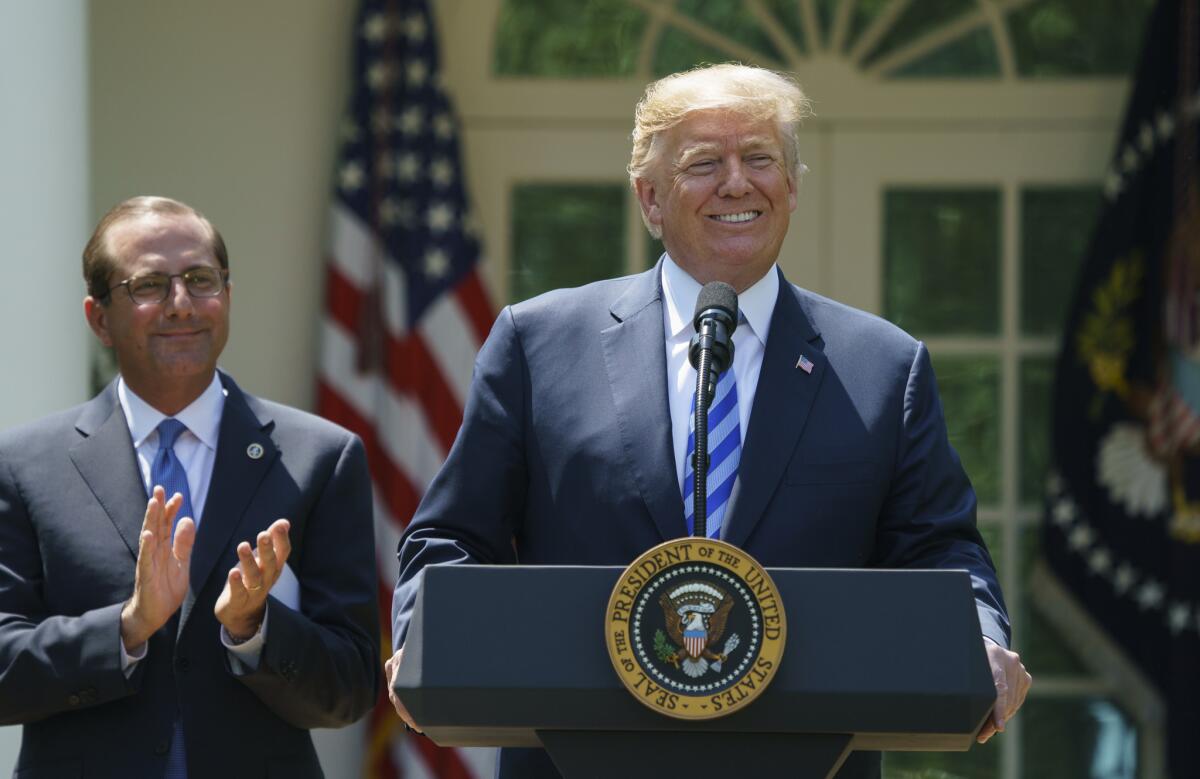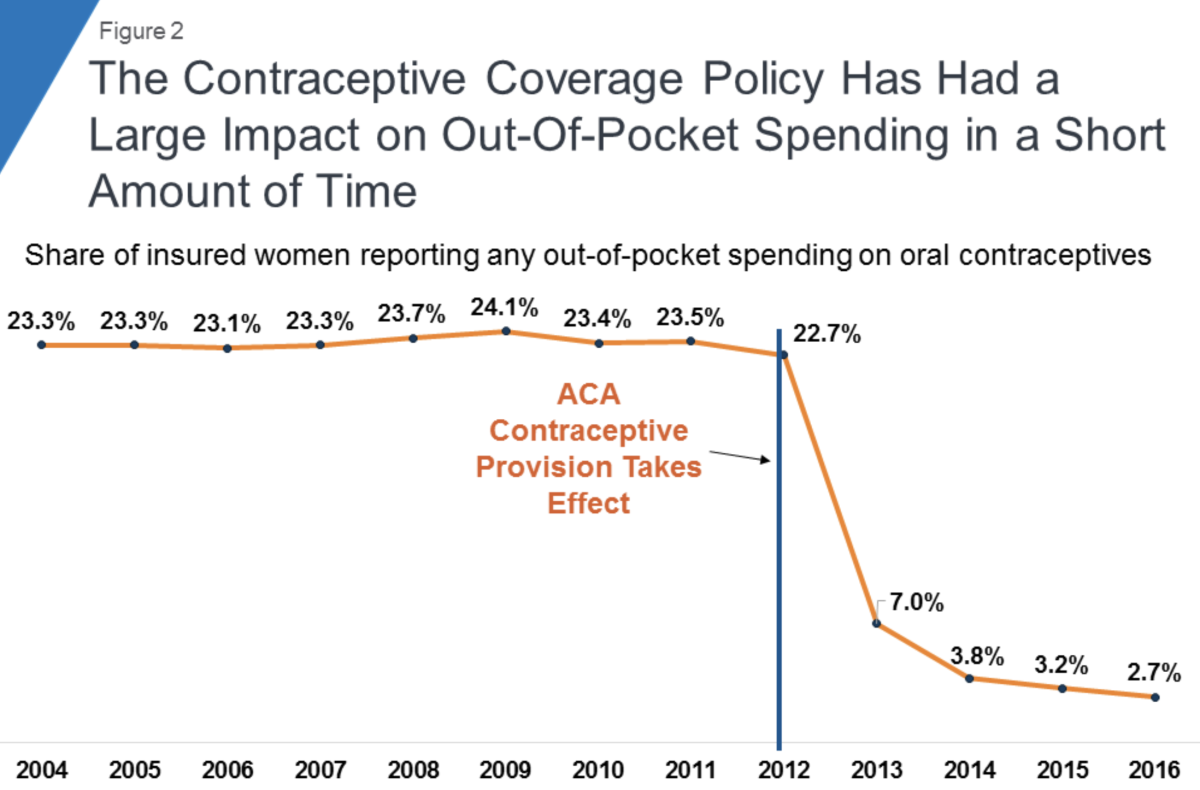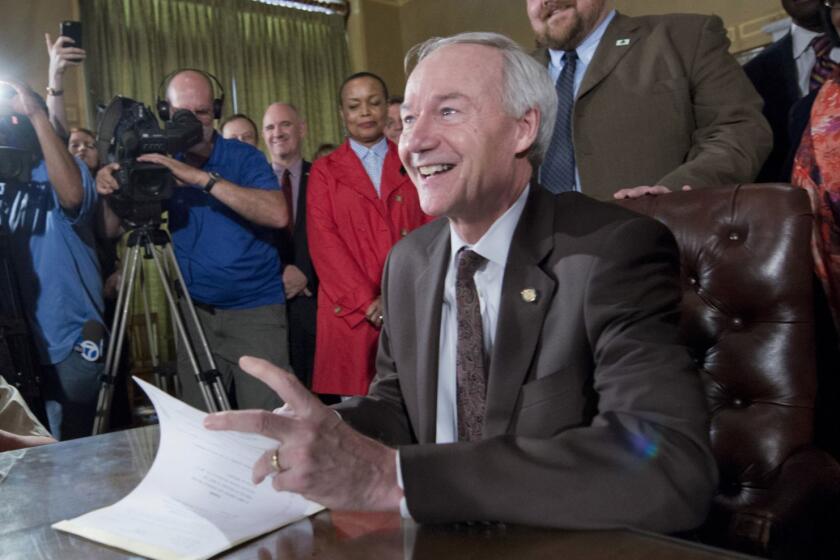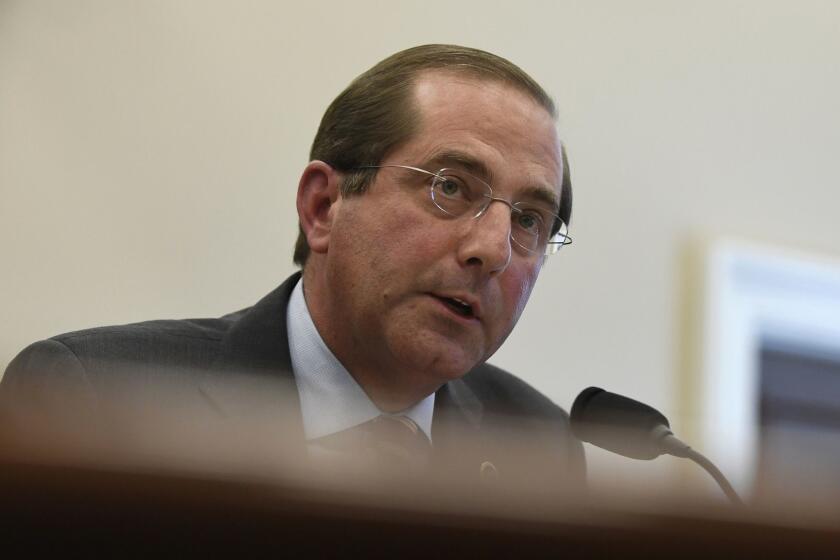Column: The 10 worst things Trump has done to harm your healthcare

- Share via
On Monday, Planned Parenthood announced that it was withdrawing from the government’s Title X program, which provides healthcare services to low-income women, because the Trump administration had saddled Title X with a “gag rule” interfering with doctors’ relationships with their patients.
The step means turning down $60 million in federal funding — the first time Planned Parenthood would go without Title X funds in the government program’s nearly half-century existence. The Trump administration denies that the rule is a “gag rule,” but that’s hard to square with its explicit provisions. The rule prohibits recipients of the funding from referring patients to abortion providers; if they give patients a list of doctors for follow-up treatments, they “cannot indicate those on the list who provide abortion.”
You propose implementing mandatory work requirements for Medicaid beneficiaries not knowing what the impact will be, across every single state. What’s the logic in that?
— Rep. Joseph P. Kennedy III, to HHS Secretary Alex Azar
Planned Parenthood serves about 1.5 million low-income women under Title X, some of whom live in areas with few or no alternative healthcare providers for women. But the gag rule is merely one of many Trump administration actions and policies that have affected people’s health for the worst. It can be hard to keep all of these initiatives straight or even to remember them all, so we’ve compiled a list of the top 10 — more precisely, the bottom 10 — so the cumulative impact is clearer.
This isn’t an exhaustive list, merely a judgment call of the worst 10. It doesn’t include measures aimed at ending anti-discrimination protections for LGBTQ patients, for instance, which are part of a broader attack on LGBTQ rights.
Because it’s the most recent, we’ll designate the gag rule as No. 1.
No. 2: Asking a court to declare the Affordable Care Act unconstitutional. In June 2018, the administration asserted in federal court that key provisions of the law are unconstitutional and refused to defend it against a legal challenge brought by 20 red states.
By throwing its weight behind a legal attack on the ACA that many legal experts consider frivolous and obtuse, Trump raised the stakes in the federal lawsuit brought by Texas and other red states. Its action placed at risk the healthcare of 133 million Americans dependent on the ACA’s individual exchange health plans or its provisions for Medicaid expansion. The case is currently under consideration by a federal appeals court.
No. 3: The “public charge” rule. This recently finalized rule requires immigration officials to reject applications from immigrants to enter or stay in the U.S. if they have received — or are judged likely to require — any of several public benefits that are tied to need. These include public health services such as Medicaid. The predictable consequence is to discourage immigrant households from accessing such programs even when they’re legally entitled.
As we reported in August 2018, when rumors of the impending rule began circulating, healthcare providers with immigrant clienteles already were seeing a reduction in patients. The director of a clinic in the Latino community of Boyle Heights in Los Angeles told me then that her monthly patient enrollments had fallen by 25% after the public-charge proposal leaked out — on top of a one-third drop after Trump’s election.
The unexampled malevolence of the Trump administration toward immigrants and the nation’s neediest residents has hardly been a secret.
Leaving aside the basic cruelty and inhumanity of a rule that instills fear in families, less healthcare for immigrants means a decline in the health profile of the entire community, raising costs for public programs and employers, among many others.
No. 4: Pulling the plug on teen pregnancy prevention. The writing was on the wall when Trump stocked the Department of Health and Human Services with advocates of abstinence-only sex education and birth control. The result became clear in June and July 2017, when 81 teen pregnancy programs around the country were told that their grants would end within the following year; one program that funded educational outreach by Children’s Hospital Los Angeles, among other institutions, was cut off immediately — just as it was beginning the second year of a five-year plan.
In all, more than $200 million in annual funding was ended. The risk is that teen pregnancies, which had been in a long-term decline, would head higher again, especially in communities with shrinking access to education and contraception.
Experts in teen pregnancy prevention were nervously holding their breaths as the Trump administration stocked key positions at the Department of Health and Human Services with advocates of ineffective abstinence-only sex education programs and opponents of birth control.
The cutoff was the handiwork of a cadre of anti-abortion activists placed into high offices at HHS. One has promoted the claim that abortion increases a woman’s chance of breast cancer and of “serious mental health problems,” which is unsupported by medical science. Another treated anti-pregnancy education as a matter of morals, not empirical data. “As public health experts and policymakers, we must normalize sexual delay more than we normalize teen sex, even with contraception,” she said. But studies consistently show that what reduces teen pregnancies is increased use of contraceptives.
No. 5: Work rules for Medicaid. The administration has gone full speed ahead on allowing states to impose work rules on residents enrolling in Medicaid, the program aimed at bringing health coverage to the poor. That’s happening despite clear evidence that the rules are catastrophic for the target population’s health coverage and do nothing to increase employment or produce job opportunities.
What happens in states that impose these rules is that thousands of enrollees are thrown off Medicaid, even if they remain eligible. That’s because the rules are hard to administer and seem almost purposefully designed to pare enrollments. That’s been noticed by federal Judge James Boasberg of Washington, D.C., who has overturned programs in Kentucky and Arkansas. Nevertheless, the administration has pushed ahead with approvals for six more states, all part of a concerted assault on Medicaid.
Ever since Arkansas implemented its first-in-the-nation work requirements for Medicaid in June 2018, the state has functioned as a laboratory for the concept of placing unnecessary obstacles in the way of low-income people seeking health coverage.
No. 6: Promoting short-term health plans. Almost from the inception of his administration, Trump has been clearing the way for the spread of short-term health plans. These are insurance plans that don’t meet ACA standards. They don’t cover all the services required by the ACA for qualifying plans, including pregnancy, mental health services and hospitalization. They reject applicants with preexisting conditions. They can impose lifetime benefit caps and weird restrictions such as refusals to cover hospitalizations that begin on a Friday or Saturday.
These plans are cheap because they’re junk. Customers often aren’t aware of their limitations until they try to access benefits. The Obama administration limited them to three-month nonrenewable terms, and some states, including California, have outlawed them entirely. Trump wants to allow them to last a year and be renewable, even though that could siphon healthier customers out of the ACA market, driving up premiums for everyone else — just one more device to sabotage the ACA.
No. 7: Appointing the worst healthcare officials. Trump began his tenure by naming former Rep. Tom Price (R-Ga.), a sworn enemy of the Affordable Care Act, to head HHS, the agency responsible for enforcing the law. Price immediately started undercutting the law. Price cut the open enrollment period for plans sold through the federal exchanges, HealthCare.gov, from three months to six weeks, then cut the budget for marketing an outreach — which was needed to inform enrollees of the change — by 90%, claiming through department flacks that previous experience suggested that outreach had “diminishing returns,” an assertion contradicted by hard evidence.
Price was ousted in October 2017 for ethical lapses, but just before leaving office, he ordered the health agency’s 10 regional directors not to participate in state-based open enrollment events, an unprecedented withdrawal of federal support. Administration sabotage of the individual insurance market during his term was tied to more than half of the average 36% premium increases sought by insurers in 20 states analyzed by Charles Gaba of ACASignups.net.
Price was succeeded by Alex Azar, a former drug company executive and lobbyist who has silently presided over a continuation of Price’s sabotage tactics. He remained mum when Trump filed papers asking the courts to declare the ACA unconstitutional, though he let it be known through pseudonymous friends that he opposed the action. (Why not go public?)
The quintessential Azar episode occurred in March, when he even acknowledged to a House committee that he had no evidence that work requirements did any good. In fact, he admitted that his department didn’t even know why 20,000 Arkansans got thrown out of Medicaid. Nor could he produce a single study validating the assertion that imposing work requirements on Medicaid recipients made them healthier or helped them find jobs.
The contest for worst Cabinet member of the Trump administration is what we might call “competitive.”
“You propose implementing mandatory work requirements for Medicaid beneficiaries not knowing what the impact will be, across every single state. What’s the logic in that?” Azar was asked by Rep. Joseph P. Kennedy III (D-Mass.). Azar didn’t have a cogent answer.
No. 8: Deliberately raising ACA premiums for 7.3 million people. In April, the administration issued a final rule for marketplace plans in 2020 that it acknowledged would raise premiums for 7.3 million consumers by cutting their premium subsidies. The administration conceded that the higher premiums would cause 70,000 people to drop marketplace coverage each year. The Center on Budget and Policy Priorities calculated that the change would cost a family of four with income of $80,000 an additional $208 annually.
The CBPP observed that the change was not required by the ACA or any other law. “The administration is making an entirely discretionary choice to raise costs for millions of people, just weeks after President Trump justified his latest efforts to repeal the ACA by arguing that it has resulted in premiums and deductibles that are too high.” In its explanation of the rule, the administration said it would move forward even though, in its own words, “all commenters on this topic expressed opposition to or concerns about the proposed change.”
No. 9: Eliminating the penalty for violating the ACA’s individual mandate. The bill cutting taxes for corporations and the wealthy that Trump signed in December 2017 included a provision reducing to zero the penalty for violating the ACA’s mandate that everyone carry insurance. The penalty was designed to prompt more young and healthy Americans to carry health insurance, which would keep premiums down for the general population.
The zeroing-out had an immediate effect on enrollment. California alone saw a 24% drop in new enrollments for 2019, the first year of the change (by more than 92,000 enrollees), almost entirely because of the penalty’s elimination. “Even robust marketing cannot offset the negative impact of its removal,” the exchange said.
No. 10: Allowing more employers to deny their workers coverage for contraception. In November 2018, the administration made final a rule vastly expanding the number of employers who could refuse to offer contraceptive coverage to their workers.

“The regulations open the door for any employer or college/university with a student health plan with objections to contraceptive coverage based on religious beliefs to qualify for an exemption, the Kaiser Family Foundation reported. “Any employer, except publicly traded corporations, with moral objections to contraception also qualify for an exemption. Their female employees, dependents, and students will no longer be entitled to coverage for the full range of FDA approved contraceptives at no cost.”
The regulatory change was just one of many assaults on women’s reproductive health.
More to Read
Inside the business of entertainment
The Wide Shot brings you news, analysis and insights on everything from streaming wars to production — and what it all means for the future.
You may occasionally receive promotional content from the Los Angeles Times.















